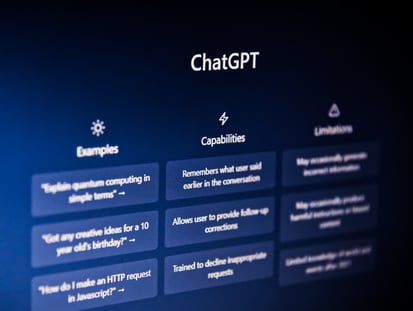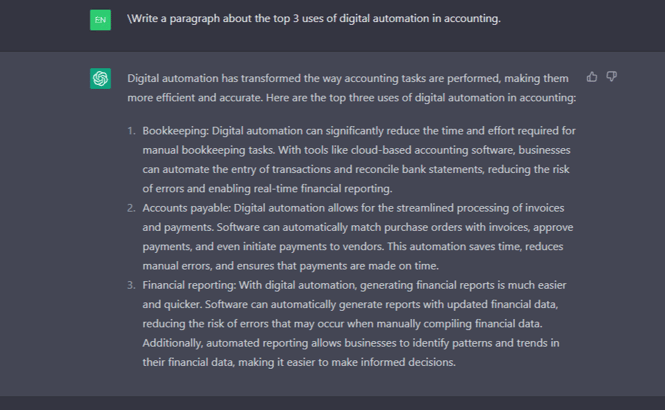Digital automation and predictive technology have been growing and maturing for decades, but their potential was often overlooked as something of a futuristic fantasy or out of reach for the everyman. That all changed overnight with the November 30, 2022, release of ChatGPT, a revolutionary new chatbot technology that is transforming the way we think about automation. By dramatically shifting the world's perception of what is possible with automation, ChatGPT opened a tractor-trailer-sized window of opportunity for businesses to get ahead in their industry. Let’s take a closer look at how this exciting technology works and why it is proving so popular among technology-forward executives.
 💡What is ChatGPT?
💡What is ChatGPT?
GPT stands for "Generative Pre-trained Transformer". ChatGPT is an AI (Artificial Intelligence) language model developed by Open AI that can generate human-like responses to almost any prompt. It was fine-tuned on a massive aggregation of conversational data, allowing it to generate text in a conversational style and respond to user inputs in a way that mimics human behavior.
Why is ChatGPT a Game Changer?
ChatGPT goes beyond traditional chatbot technology in ways that were previously impossible. Rather than relying solely on predefined scripts and responses, ChatGPT uses AI-driven natural language processing to enable conversations that feel human and organic without requiring added effort from users or developers.
But a mere technical description does not begin to do ChatGPT justice. It is not just how it works, but how magically it works! It can instantly write a perfectly lucid (and somewhat accurate) essay on the topic of your choice, and then, at your prompting, convert that essay into a rap song … a Shakespearean sonnet…or just about any style or form of writing you can imagine. It is this seemingly supernatural ability that has taken the world by storm and caused ChatGPT to break all prior records in the adoption of technology, surpassing its first 1 million users (about the population of Delaware) within 5 days of being released.
And this is why ChatGPT matters. Not necessarily because it will be directly employed by a significant percentage of companies (though that is certainly possible too), but because it has dramatically shifted the perspective of every executive, every employee, every client, every investor, and every competitor toward the possibilities of AI (Artificial Intelligence). Just as Sputnik triggered the Space Race, Chat GPT has triggered an AI race in which organizations of all sizes and types are now actively grappling with the question of how they might harness the power of this remarkable technology.
Companies that have not yet embraced automation must look immediately. We have reached a tipping point between automation curiosity and automation necessity. Those who embrace automation will do business faster, more accurately, and better use their resources...those who do not will lose their competitive edge.
How to Leverage the ChatGPT Moment to Foster Automation Within Your Company in 5 Steps
ChatGPT is not limited to answering cursory questions, aiding in business content writing, or supplying entertainment (although from our personal experience, it makes a fun dinner party game). ChatGPT can be used to enable an automation-first mindset within organizations to lay the groundwork for future RPA (Robotic Process Automation) solutions.
1. Host a ChatGPT Demo.
Invite your executive team and prepare an inquiry that could help your organization directly. Describe the kind of output you hope to receive, for example, “Write a paragraph about the top 3 uses of digital automation in accounting.” Use this to spark a broader conversation. Automation is mainstream now, so how do we keep up?

2. Highlight some of the AI (Artificial Intelligence) tools and RPA (Robotic Process Automation) tools that can solve specific problems or use cases for your industry.
Here are just a few examples of automation use cases to spark your thinking.
- AI chatbots for client aid in banking so key human resources are left for the most complex questions.
- Automation of EHR (Electronic Health Records) management in healthcare to limit data entry in hospitals and doctors' offices.
- Automation in employee onboarding to create a seamless experience between offer acceptance and the first day – meaning the first day is focused on job orientation rather than paperwork.
- Automation of accounts payable/receivable to improve cash flow, limit turnaround time, and reduce the burden on accounting employees.
3. Ask your team how this technology will affect client expectations within 1 year or 5 years
As an example, in banking and lending, what visibility to in-process loans or account information do clients expect? Are systems or employees able to deliver client expectations quickly? If clients are expecting a ‘live chat’ experience, but you do not have the resources to staff it, could a tool like ChatGPT be used to enhance customer experience?
4. Ask your team to consider how this technology will affect the competitive dynamics of your industry within 1 year or 5 years.
Are you aware of any competitors that already have automation embedded into their everyday processes? How has their embrace of automation shifted client expectations? Are your competitors able to return results faster or act on new competitive information more quickly than your team? There is nothing like a little FOMO (Fear of Missing Out) to inspire forward thinking.
5. Present a roadmap to become an "automation first" company:
- Begin with Process Automation
A thorough understanding of the state of your current business processes is essential before the introduction of any modern technology. Focus first on processes where automation would benefit a specific area of your company like invoicing, payroll, or gathering client data from multiple systems. Where is your organization most overburdened? Is your finance team constantly overburdened with reporting? Is your accounting team falling behind with (ICR) intercompany reconciliations? Once a key process is automated, it opens the lens of possibility to other areas of the company. - Embed Automation in Your Culture
It is important to start by recognizing the potential savings that automation can bring. Automation can reduce manual labor costs, improve the accuracy and consistency of results, and expedite workflows. Savings go beyond costs though, and automation can save precious time for employees and allow them to focus on less tedious and more rewarding work. Employees should be encouraged to identify tasks that could be automated to maximize efficiency and productivity. Additionally, resources should be provided to help employees become familiar with automation tools like robotic process automation (RPA), natural language processing (NLP), and AI chatbots. Lastly, data about automation benefits should be collected and shared so that stakeholders understand the value of automating processes. - Begin a framework for Low Code/No Code & Citizen Developers
As the next step to rewarding employees for thinking about automation first, consider a citizen developer path. Make sure automation resources are both well-defined and easily available to all employees. Each employee represents a unique point of view. Reward their automation creativity by supplying the tools they need to be successful. By creating a framework for them to follow, the lasting effects of their automation ideas are more likely to be used by your company.
Executives who once shrugged off automation as a futuristic fantasy are now ready to listen—just as the COVID-19 pandemic created an opening for virtual work around the world, the feverish spread of ChatGPT has created an opening for automation solutions in every sector imaginable. Be sure you are ready to climb through the window before it closes.

